Factors Influencing Successful Digital Servitization Strategy
VerifiedAdded on 2020/04/01
|21
|4167
|218
Project
AI Summary
This research proposal investigates the factors influencing the successful implementation of a new digital Servitization strategy within the private healthcare sector in Malaysia. The study aims to identify key factors, such as those outlined in the McKinsey 7-S model, that impact the effective integration of digital services to enhance patient engagement and improve service levels. The proposal highlights the growing importance of the Malaysian healthcare industry and the government's focus on health tourism, making digital Servitization a crucial strategy for differentiation. The research will employ a survey methodology, collecting data from managers of private healthcare centers in Malaysia, and utilize statistical techniques like Structural Equation Modeling to analyze the data and determine the significance of various factors. The literature review covers Servitization, strategy implementation, and the Malaysian healthcare industry, identifying a research gap in the context of digital Servitization in the Malaysian private healthcare sector. The study's objectives include understanding the influencing factors and their impact, contributing to existing knowledge, and providing insights for healthcare managers to optimize their strategies.
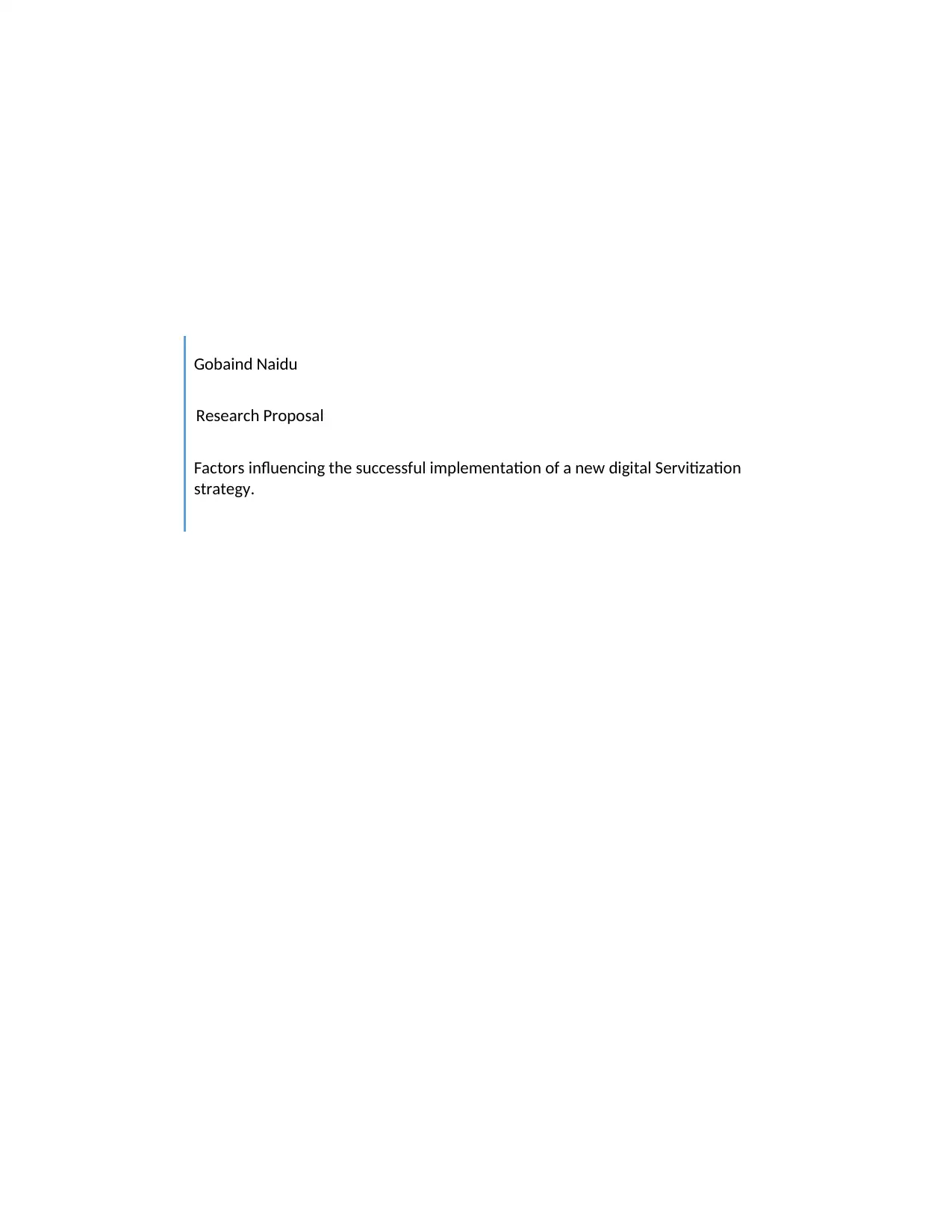
Gobaind Naidu
Research Proposal
Factors influencing the successful implementation of a new digital Servitization
strategy.
Research Proposal
Factors influencing the successful implementation of a new digital Servitization
strategy.
Paraphrase This Document
Need a fresh take? Get an instant paraphrase of this document with our AI Paraphraser
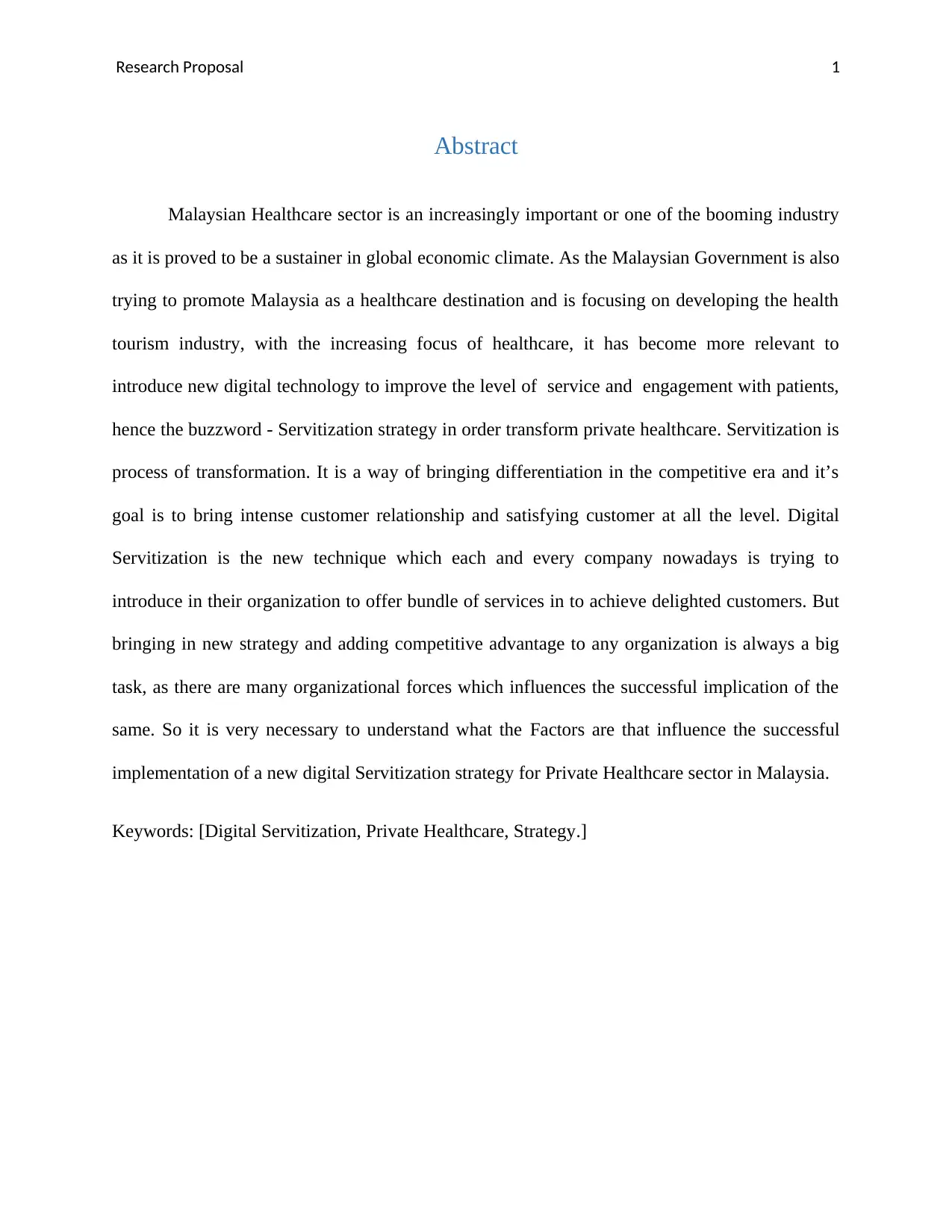
Research Proposal 1
Abstract
Malaysian Healthcare sector is an increasingly important or one of the booming industry
as it is proved to be a sustainer in global economic climate. As the Malaysian Government is also
trying to promote Malaysia as a healthcare destination and is focusing on developing the health
tourism industry, with the increasing focus of healthcare, it has become more relevant to
introduce new digital technology to improve the level of service and engagement with patients,
hence the buzzword - Servitization strategy in order transform private healthcare. Servitization is
process of transformation. It is a way of bringing differentiation in the competitive era and it’s
goal is to bring intense customer relationship and satisfying customer at all the level. Digital
Servitization is the new technique which each and every company nowadays is trying to
introduce in their organization to offer bundle of services in to achieve delighted customers. But
bringing in new strategy and adding competitive advantage to any organization is always a big
task, as there are many organizational forces which influences the successful implication of the
same. So it is very necessary to understand what the Factors are that influence the successful
implementation of a new digital Servitization strategy for Private Healthcare sector in Malaysia.
Keywords: [Digital Servitization, Private Healthcare, Strategy.]
Abstract
Malaysian Healthcare sector is an increasingly important or one of the booming industry
as it is proved to be a sustainer in global economic climate. As the Malaysian Government is also
trying to promote Malaysia as a healthcare destination and is focusing on developing the health
tourism industry, with the increasing focus of healthcare, it has become more relevant to
introduce new digital technology to improve the level of service and engagement with patients,
hence the buzzword - Servitization strategy in order transform private healthcare. Servitization is
process of transformation. It is a way of bringing differentiation in the competitive era and it’s
goal is to bring intense customer relationship and satisfying customer at all the level. Digital
Servitization is the new technique which each and every company nowadays is trying to
introduce in their organization to offer bundle of services in to achieve delighted customers. But
bringing in new strategy and adding competitive advantage to any organization is always a big
task, as there are many organizational forces which influences the successful implication of the
same. So it is very necessary to understand what the Factors are that influence the successful
implementation of a new digital Servitization strategy for Private Healthcare sector in Malaysia.
Keywords: [Digital Servitization, Private Healthcare, Strategy.]
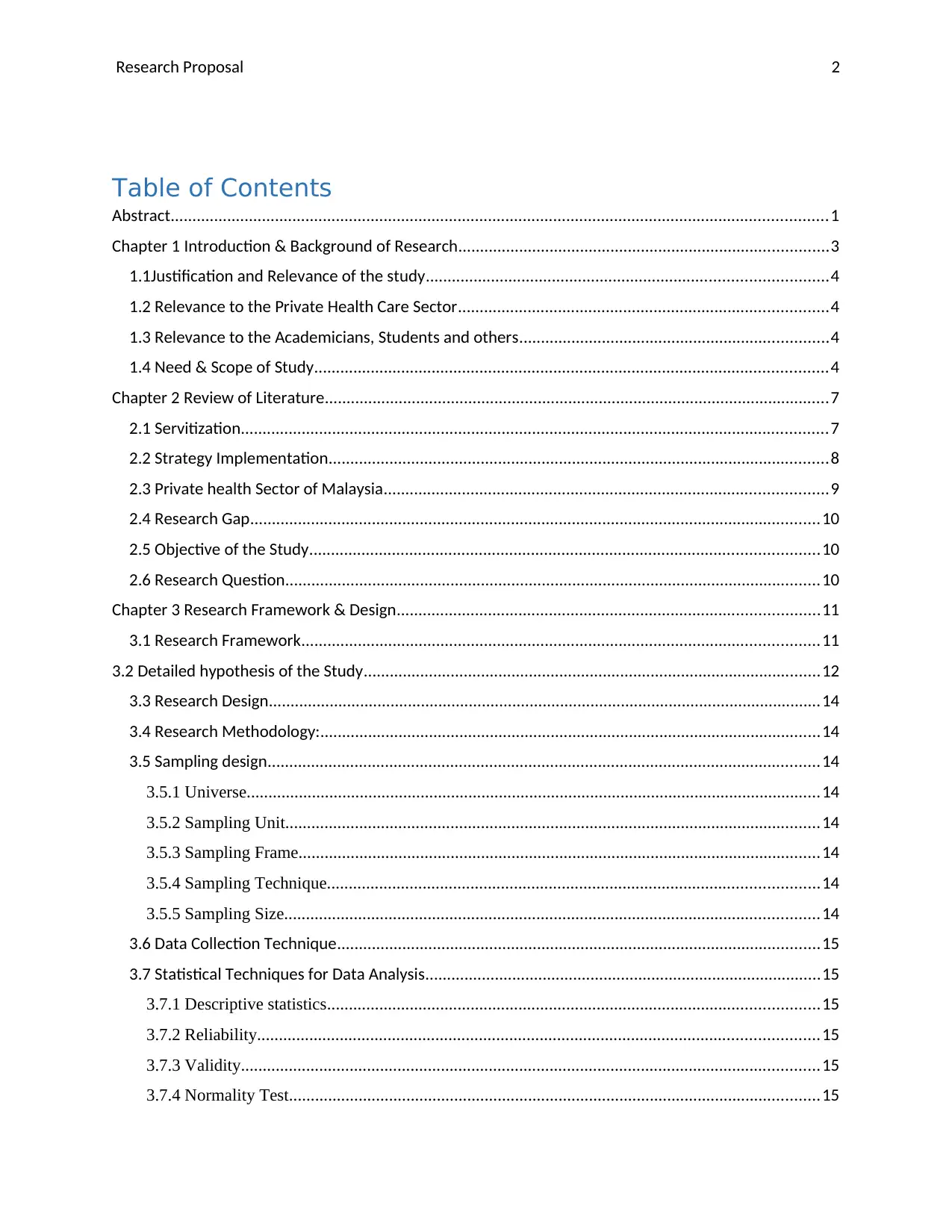
Research Proposal 2
Table of Contents
Abstract.......................................................................................................................................................1
Chapter 1 Introduction & Background of Research.....................................................................................3
1.1Justification and Relevance of the study............................................................................................4
1.2 Relevance to the Private Health Care Sector.....................................................................................4
1.3 Relevance to the Academicians, Students and others.......................................................................4
1.4 Need & Scope of Study......................................................................................................................4
Chapter 2 Review of Literature....................................................................................................................7
2.1 Servitization.......................................................................................................................................7
2.2 Strategy Implementation...................................................................................................................8
2.3 Private health Sector of Malaysia......................................................................................................9
2.4 Research Gap...................................................................................................................................10
2.5 Objective of the Study.....................................................................................................................10
2.6 Research Question...........................................................................................................................10
Chapter 3 Research Framework & Design.................................................................................................11
3.1 Research Framework.......................................................................................................................11
3.2 Detailed hypothesis of the Study.........................................................................................................12
3.3 Research Design...............................................................................................................................14
3.4 Research Methodology:...................................................................................................................14
3.5 Sampling design...............................................................................................................................14
3.5.1 Universe....................................................................................................................................14
3.5.2 Sampling Unit...........................................................................................................................14
3.5.3 Sampling Frame........................................................................................................................14
3.5.4 Sampling Technique.................................................................................................................14
3.5.5 Sampling Size...........................................................................................................................14
3.6 Data Collection Technique...............................................................................................................15
3.7 Statistical Techniques for Data Analysis...........................................................................................15
3.7.1 Descriptive statistics.................................................................................................................15
3.7.2 Reliability.................................................................................................................................15
3.7.3 Validity.....................................................................................................................................15
3.7.4 Normality Test..........................................................................................................................15
Table of Contents
Abstract.......................................................................................................................................................1
Chapter 1 Introduction & Background of Research.....................................................................................3
1.1Justification and Relevance of the study............................................................................................4
1.2 Relevance to the Private Health Care Sector.....................................................................................4
1.3 Relevance to the Academicians, Students and others.......................................................................4
1.4 Need & Scope of Study......................................................................................................................4
Chapter 2 Review of Literature....................................................................................................................7
2.1 Servitization.......................................................................................................................................7
2.2 Strategy Implementation...................................................................................................................8
2.3 Private health Sector of Malaysia......................................................................................................9
2.4 Research Gap...................................................................................................................................10
2.5 Objective of the Study.....................................................................................................................10
2.6 Research Question...........................................................................................................................10
Chapter 3 Research Framework & Design.................................................................................................11
3.1 Research Framework.......................................................................................................................11
3.2 Detailed hypothesis of the Study.........................................................................................................12
3.3 Research Design...............................................................................................................................14
3.4 Research Methodology:...................................................................................................................14
3.5 Sampling design...............................................................................................................................14
3.5.1 Universe....................................................................................................................................14
3.5.2 Sampling Unit...........................................................................................................................14
3.5.3 Sampling Frame........................................................................................................................14
3.5.4 Sampling Technique.................................................................................................................14
3.5.5 Sampling Size...........................................................................................................................14
3.6 Data Collection Technique...............................................................................................................15
3.7 Statistical Techniques for Data Analysis...........................................................................................15
3.7.1 Descriptive statistics.................................................................................................................15
3.7.2 Reliability.................................................................................................................................15
3.7.3 Validity.....................................................................................................................................15
3.7.4 Normality Test..........................................................................................................................15
⊘ This is a preview!⊘
Do you want full access?
Subscribe today to unlock all pages.

Trusted by 1+ million students worldwide

Research Proposal 3
3.7.5 Hypothesis Testing...................................................................................................................15
3.8 Limitations of the study...................................................................................................................15
References.................................................................................................................................................17
3.7.5 Hypothesis Testing...................................................................................................................15
3.8 Limitations of the study...................................................................................................................15
References.................................................................................................................................................17
Paraphrase This Document
Need a fresh take? Get an instant paraphrase of this document with our AI Paraphraser
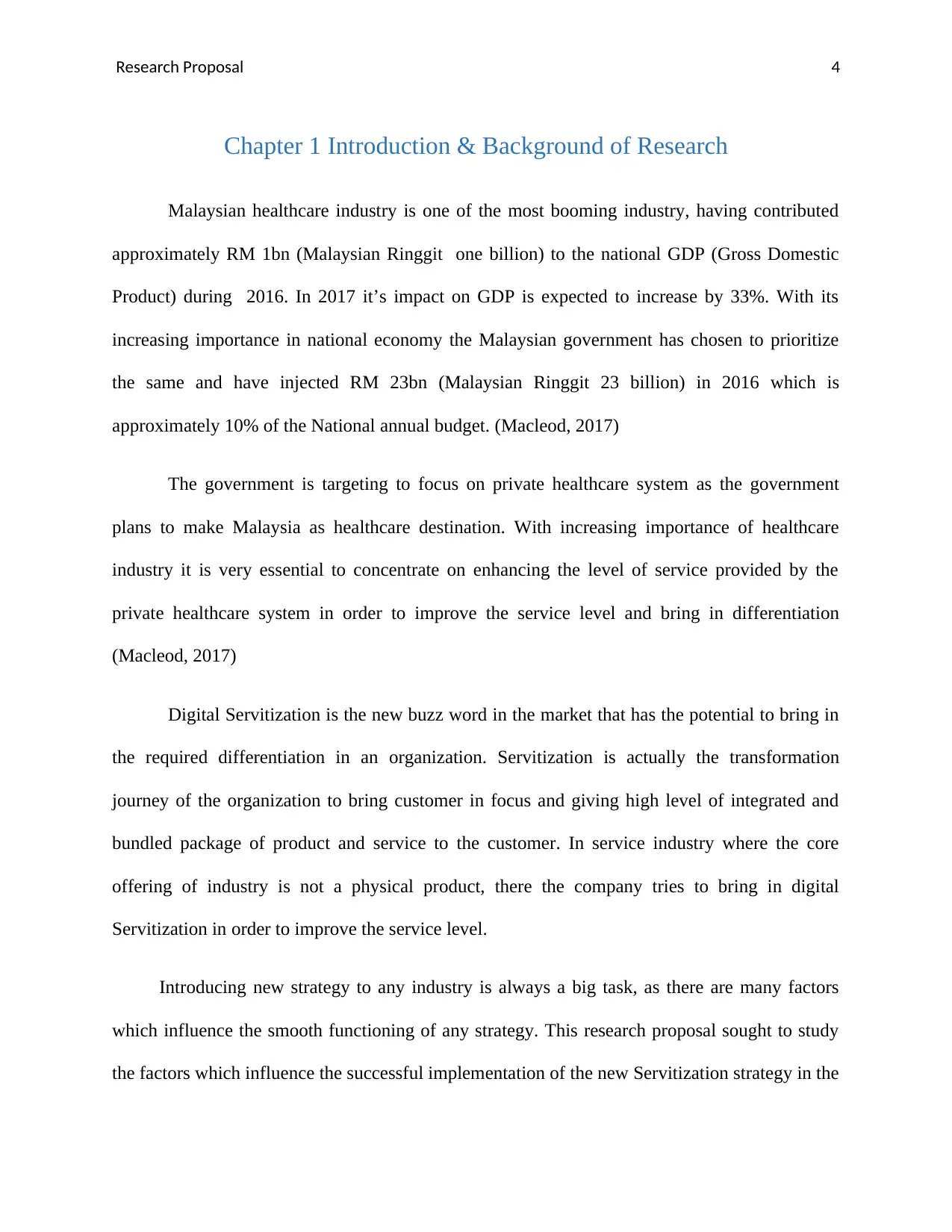
Research Proposal 4
Chapter 1 Introduction & Background of Research
Malaysian healthcare industry is one of the most booming industry, having contributed
approximately RM 1bn (Malaysian Ringgit one billion) to the national GDP (Gross Domestic
Product) during 2016. In 2017 it’s impact on GDP is expected to increase by 33%. With its
increasing importance in national economy the Malaysian government has chosen to prioritize
the same and have injected RM 23bn (Malaysian Ringgit 23 billion) in 2016 which is
approximately 10% of the National annual budget. (Macleod, 2017)
The government is targeting to focus on private healthcare system as the government
plans to make Malaysia as healthcare destination. With increasing importance of healthcare
industry it is very essential to concentrate on enhancing the level of service provided by the
private healthcare system in order to improve the service level and bring in differentiation
(Macleod, 2017)
Digital Servitization is the new buzz word in the market that has the potential to bring in
the required differentiation in an organization. Servitization is actually the transformation
journey of the organization to bring customer in focus and giving high level of integrated and
bundled package of product and service to the customer. In service industry where the core
offering of industry is not a physical product, there the company tries to bring in digital
Servitization in order to improve the service level.
Introducing new strategy to any industry is always a big task, as there are many factors
which influence the smooth functioning of any strategy. This research proposal sought to study
the factors which influence the successful implementation of the new Servitization strategy in the
Chapter 1 Introduction & Background of Research
Malaysian healthcare industry is one of the most booming industry, having contributed
approximately RM 1bn (Malaysian Ringgit one billion) to the national GDP (Gross Domestic
Product) during 2016. In 2017 it’s impact on GDP is expected to increase by 33%. With its
increasing importance in national economy the Malaysian government has chosen to prioritize
the same and have injected RM 23bn (Malaysian Ringgit 23 billion) in 2016 which is
approximately 10% of the National annual budget. (Macleod, 2017)
The government is targeting to focus on private healthcare system as the government
plans to make Malaysia as healthcare destination. With increasing importance of healthcare
industry it is very essential to concentrate on enhancing the level of service provided by the
private healthcare system in order to improve the service level and bring in differentiation
(Macleod, 2017)
Digital Servitization is the new buzz word in the market that has the potential to bring in
the required differentiation in an organization. Servitization is actually the transformation
journey of the organization to bring customer in focus and giving high level of integrated and
bundled package of product and service to the customer. In service industry where the core
offering of industry is not a physical product, there the company tries to bring in digital
Servitization in order to improve the service level.
Introducing new strategy to any industry is always a big task, as there are many factors
which influence the smooth functioning of any strategy. This research proposal sought to study
the factors which influence the successful implementation of the new Servitization strategy in the
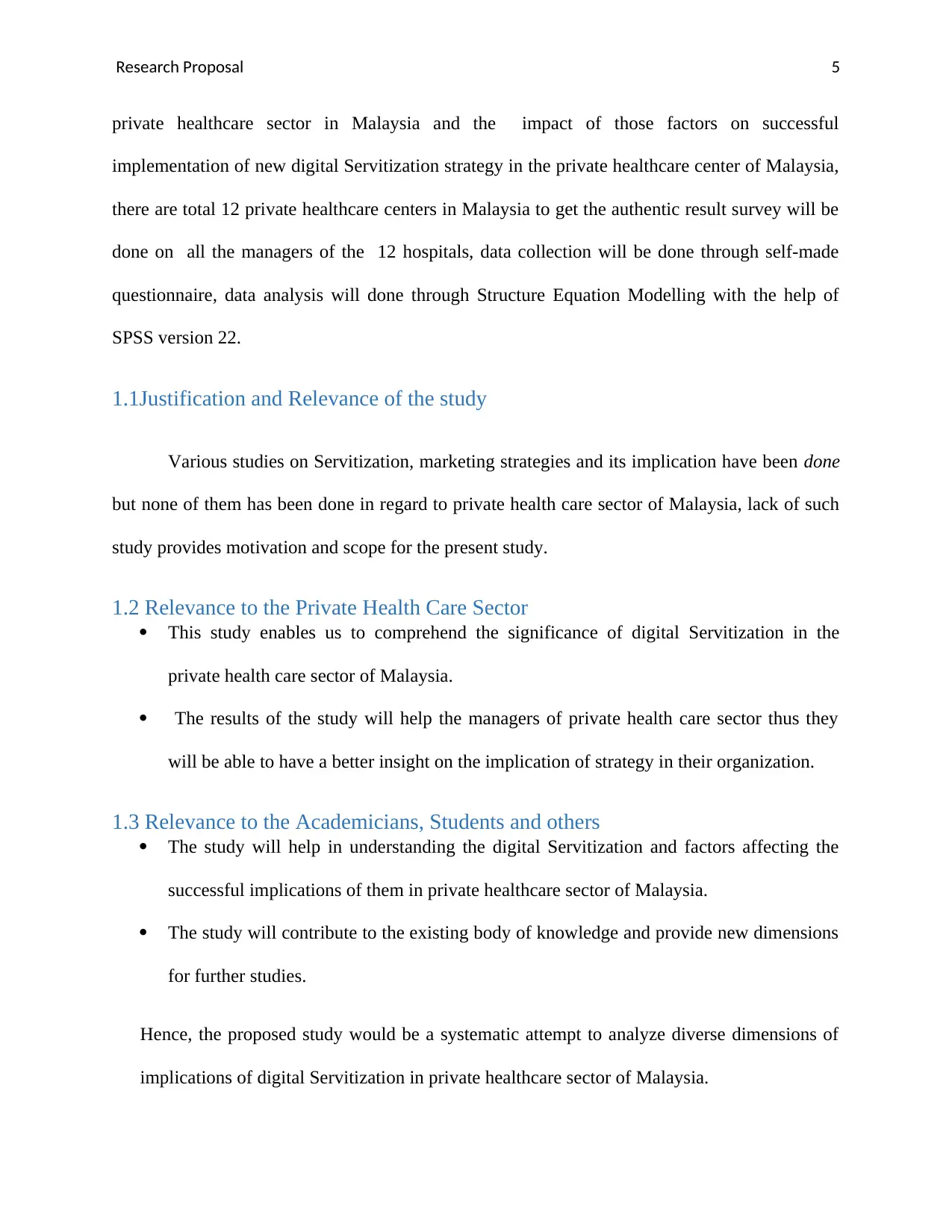
Research Proposal 5
private healthcare sector in Malaysia and the impact of those factors on successful
implementation of new digital Servitization strategy in the private healthcare center of Malaysia,
there are total 12 private healthcare centers in Malaysia to get the authentic result survey will be
done on all the managers of the 12 hospitals, data collection will be done through self-made
questionnaire, data analysis will done through Structure Equation Modelling with the help of
SPSS version 22.
1.1Justification and Relevance of the study
Various studies on Servitization, marketing strategies and its implication have been done
but none of them has been done in regard to private health care sector of Malaysia, lack of such
study provides motivation and scope for the present study.
1.2 Relevance to the Private Health Care Sector
This study enables us to comprehend the significance of digital Servitization in the
private health care sector of Malaysia.
The results of the study will help the managers of private health care sector thus they
will be able to have a better insight on the implication of strategy in their organization.
1.3 Relevance to the Academicians, Students and others
The study will help in understanding the digital Servitization and factors affecting the
successful implications of them in private healthcare sector of Malaysia.
The study will contribute to the existing body of knowledge and provide new dimensions
for further studies.
Hence, the proposed study would be a systematic attempt to analyze diverse dimensions of
implications of digital Servitization in private healthcare sector of Malaysia.
private healthcare sector in Malaysia and the impact of those factors on successful
implementation of new digital Servitization strategy in the private healthcare center of Malaysia,
there are total 12 private healthcare centers in Malaysia to get the authentic result survey will be
done on all the managers of the 12 hospitals, data collection will be done through self-made
questionnaire, data analysis will done through Structure Equation Modelling with the help of
SPSS version 22.
1.1Justification and Relevance of the study
Various studies on Servitization, marketing strategies and its implication have been done
but none of them has been done in regard to private health care sector of Malaysia, lack of such
study provides motivation and scope for the present study.
1.2 Relevance to the Private Health Care Sector
This study enables us to comprehend the significance of digital Servitization in the
private health care sector of Malaysia.
The results of the study will help the managers of private health care sector thus they
will be able to have a better insight on the implication of strategy in their organization.
1.3 Relevance to the Academicians, Students and others
The study will help in understanding the digital Servitization and factors affecting the
successful implications of them in private healthcare sector of Malaysia.
The study will contribute to the existing body of knowledge and provide new dimensions
for further studies.
Hence, the proposed study would be a systematic attempt to analyze diverse dimensions of
implications of digital Servitization in private healthcare sector of Malaysia.
⊘ This is a preview!⊘
Do you want full access?
Subscribe today to unlock all pages.

Trusted by 1+ million students worldwide
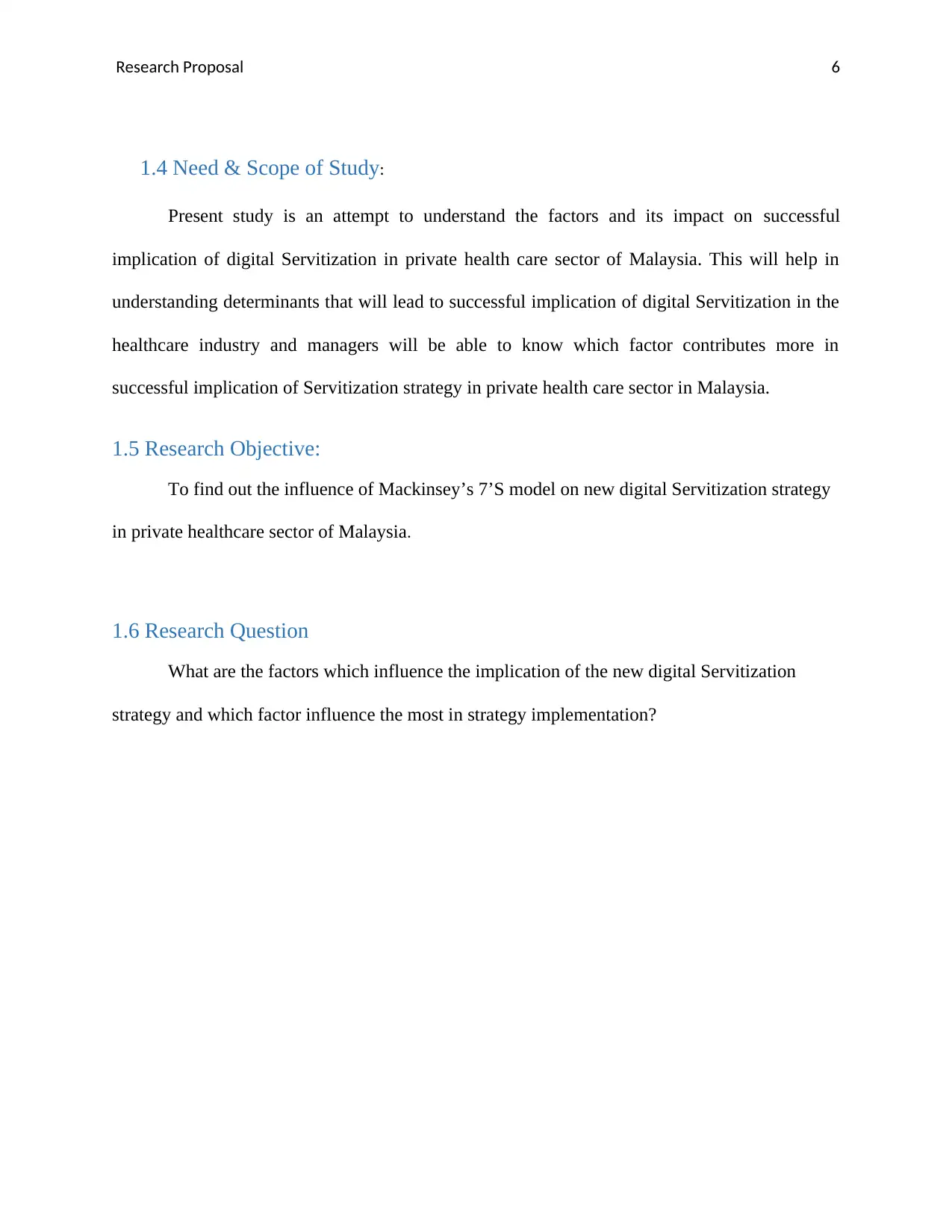
Research Proposal 6
1.4 Need & Scope of Study:
Present study is an attempt to understand the factors and its impact on successful
implication of digital Servitization in private health care sector of Malaysia. This will help in
understanding determinants that will lead to successful implication of digital Servitization in the
healthcare industry and managers will be able to know which factor contributes more in
successful implication of Servitization strategy in private health care sector in Malaysia.
1.5 Research Objective:
To find out the influence of Mackinsey’s 7’S model on new digital Servitization strategy
in private healthcare sector of Malaysia.
1.6 Research Question
What are the factors which influence the implication of the new digital Servitization
strategy and which factor influence the most in strategy implementation?
1.4 Need & Scope of Study:
Present study is an attempt to understand the factors and its impact on successful
implication of digital Servitization in private health care sector of Malaysia. This will help in
understanding determinants that will lead to successful implication of digital Servitization in the
healthcare industry and managers will be able to know which factor contributes more in
successful implication of Servitization strategy in private health care sector in Malaysia.
1.5 Research Objective:
To find out the influence of Mackinsey’s 7’S model on new digital Servitization strategy
in private healthcare sector of Malaysia.
1.6 Research Question
What are the factors which influence the implication of the new digital Servitization
strategy and which factor influence the most in strategy implementation?
Paraphrase This Document
Need a fresh take? Get an instant paraphrase of this document with our AI Paraphraser
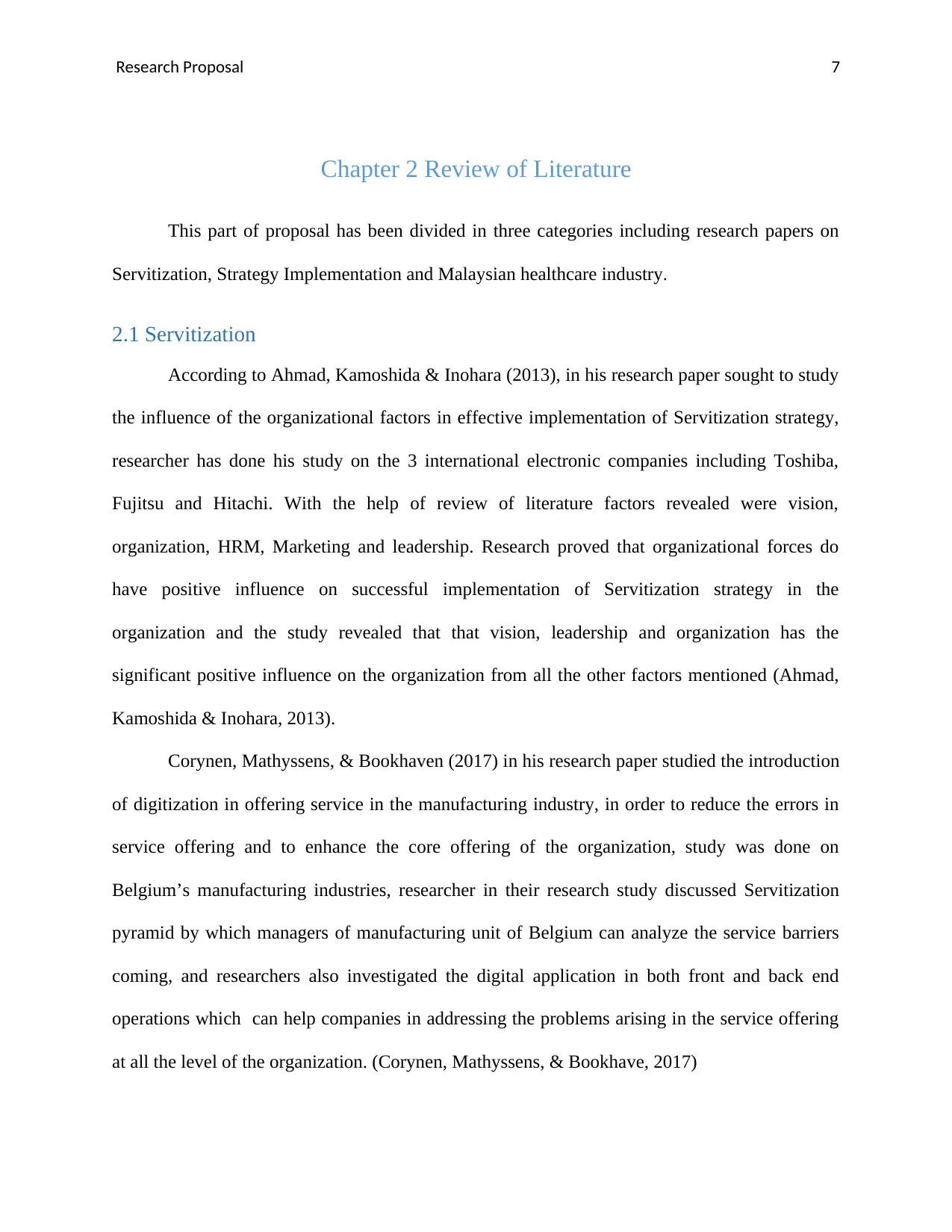
Research Proposal 7
Chapter 2 Review of Literature
This part of proposal has been divided in three categories including research papers on
Servitization, Strategy Implementation and Malaysian healthcare industry.
2.1 Servitization
According to Ahmad, Kamoshida & Inohara (2013), in his research paper sought to study
the influence of the organizational factors in effective implementation of Servitization strategy,
researcher has done his study on the 3 international electronic companies including Toshiba,
Fujitsu and Hitachi. With the help of review of literature factors revealed were vision,
organization, HRM, Marketing and leadership. Research proved that organizational forces do
have positive influence on successful implementation of Servitization strategy in the
organization and the study revealed that that vision, leadership and organization has the
significant positive influence on the organization from all the other factors mentioned (Ahmad,
Kamoshida & Inohara, 2013).
Corynen, Mathyssens, & Bookhaven (2017) in his research paper studied the introduction
of digitization in offering service in the manufacturing industry, in order to reduce the errors in
service offering and to enhance the core offering of the organization, study was done on
Belgium’s manufacturing industries, researcher in their research study discussed Servitization
pyramid by which managers of manufacturing unit of Belgium can analyze the service barriers
coming, and researchers also investigated the digital application in both front and back end
operations which can help companies in addressing the problems arising in the service offering
at all the level of the organization. (Corynen, Mathyssens, & Bookhave, 2017)
Chapter 2 Review of Literature
This part of proposal has been divided in three categories including research papers on
Servitization, Strategy Implementation and Malaysian healthcare industry.
2.1 Servitization
According to Ahmad, Kamoshida & Inohara (2013), in his research paper sought to study
the influence of the organizational factors in effective implementation of Servitization strategy,
researcher has done his study on the 3 international electronic companies including Toshiba,
Fujitsu and Hitachi. With the help of review of literature factors revealed were vision,
organization, HRM, Marketing and leadership. Research proved that organizational forces do
have positive influence on successful implementation of Servitization strategy in the
organization and the study revealed that that vision, leadership and organization has the
significant positive influence on the organization from all the other factors mentioned (Ahmad,
Kamoshida & Inohara, 2013).
Corynen, Mathyssens, & Bookhaven (2017) in his research paper studied the introduction
of digitization in offering service in the manufacturing industry, in order to reduce the errors in
service offering and to enhance the core offering of the organization, study was done on
Belgium’s manufacturing industries, researcher in their research study discussed Servitization
pyramid by which managers of manufacturing unit of Belgium can analyze the service barriers
coming, and researchers also investigated the digital application in both front and back end
operations which can help companies in addressing the problems arising in the service offering
at all the level of the organization. (Corynen, Mathyssens, & Bookhave, 2017)
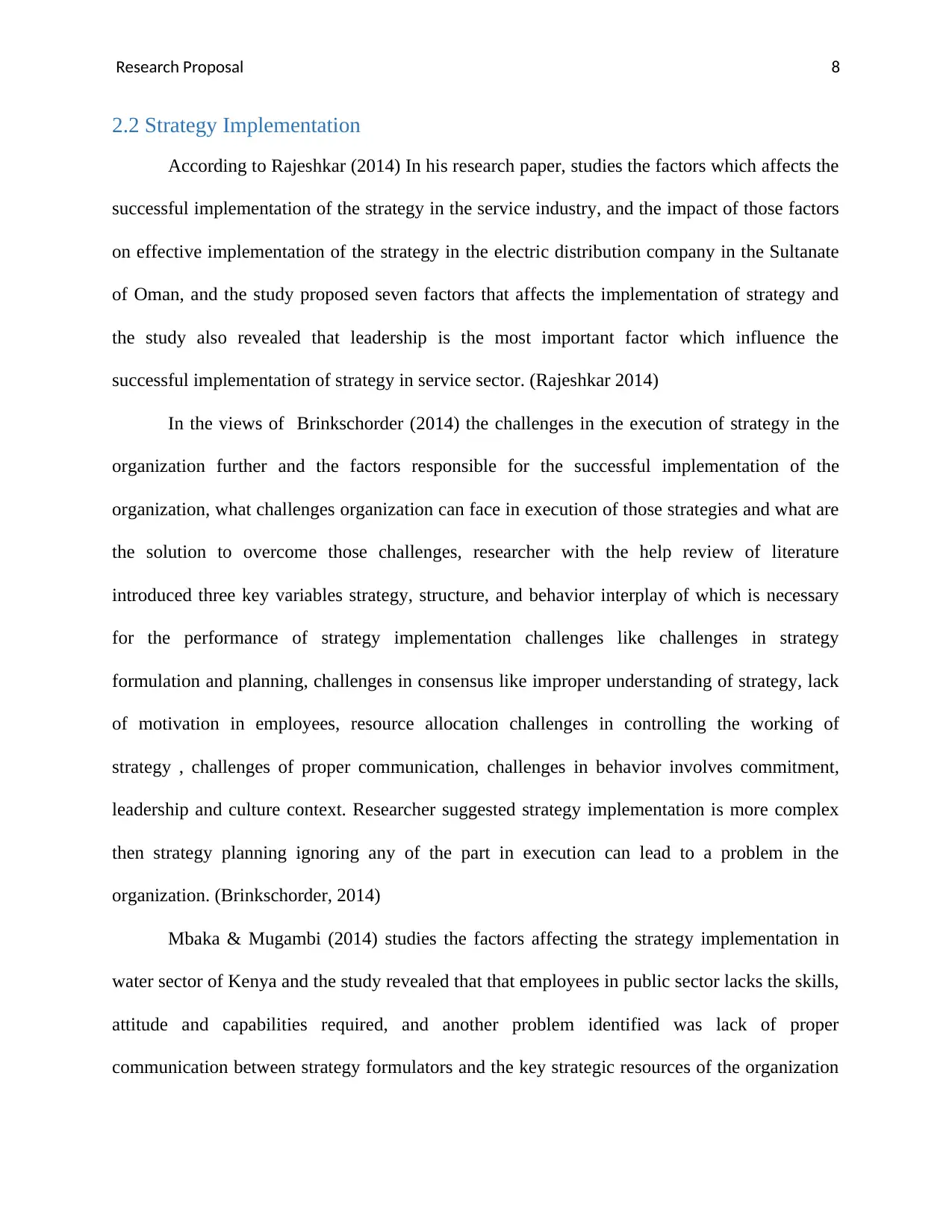
Research Proposal 8
2.2 Strategy Implementation
According to Rajeshkar (2014) In his research paper, studies the factors which affects the
successful implementation of the strategy in the service industry, and the impact of those factors
on effective implementation of the strategy in the electric distribution company in the Sultanate
of Oman, and the study proposed seven factors that affects the implementation of strategy and
the study also revealed that leadership is the most important factor which influence the
successful implementation of strategy in service sector. (Rajeshkar 2014)
In the views of Brinkschorder (2014) the challenges in the execution of strategy in the
organization further and the factors responsible for the successful implementation of the
organization, what challenges organization can face in execution of those strategies and what are
the solution to overcome those challenges, researcher with the help review of literature
introduced three key variables strategy, structure, and behavior interplay of which is necessary
for the performance of strategy implementation challenges like challenges in strategy
formulation and planning, challenges in consensus like improper understanding of strategy, lack
of motivation in employees, resource allocation challenges in controlling the working of
strategy , challenges of proper communication, challenges in behavior involves commitment,
leadership and culture context. Researcher suggested strategy implementation is more complex
then strategy planning ignoring any of the part in execution can lead to a problem in the
organization. (Brinkschorder, 2014)
Mbaka & Mugambi (2014) studies the factors affecting the strategy implementation in
water sector of Kenya and the study revealed that that employees in public sector lacks the skills,
attitude and capabilities required, and another problem identified was lack of proper
communication between strategy formulators and the key strategic resources of the organization
2.2 Strategy Implementation
According to Rajeshkar (2014) In his research paper, studies the factors which affects the
successful implementation of the strategy in the service industry, and the impact of those factors
on effective implementation of the strategy in the electric distribution company in the Sultanate
of Oman, and the study proposed seven factors that affects the implementation of strategy and
the study also revealed that leadership is the most important factor which influence the
successful implementation of strategy in service sector. (Rajeshkar 2014)
In the views of Brinkschorder (2014) the challenges in the execution of strategy in the
organization further and the factors responsible for the successful implementation of the
organization, what challenges organization can face in execution of those strategies and what are
the solution to overcome those challenges, researcher with the help review of literature
introduced three key variables strategy, structure, and behavior interplay of which is necessary
for the performance of strategy implementation challenges like challenges in strategy
formulation and planning, challenges in consensus like improper understanding of strategy, lack
of motivation in employees, resource allocation challenges in controlling the working of
strategy , challenges of proper communication, challenges in behavior involves commitment,
leadership and culture context. Researcher suggested strategy implementation is more complex
then strategy planning ignoring any of the part in execution can lead to a problem in the
organization. (Brinkschorder, 2014)
Mbaka & Mugambi (2014) studies the factors affecting the strategy implementation in
water sector of Kenya and the study revealed that that employees in public sector lacks the skills,
attitude and capabilities required, and another problem identified was lack of proper
communication between strategy formulators and the key strategic resources of the organization
⊘ This is a preview!⊘
Do you want full access?
Subscribe today to unlock all pages.

Trusted by 1+ million students worldwide
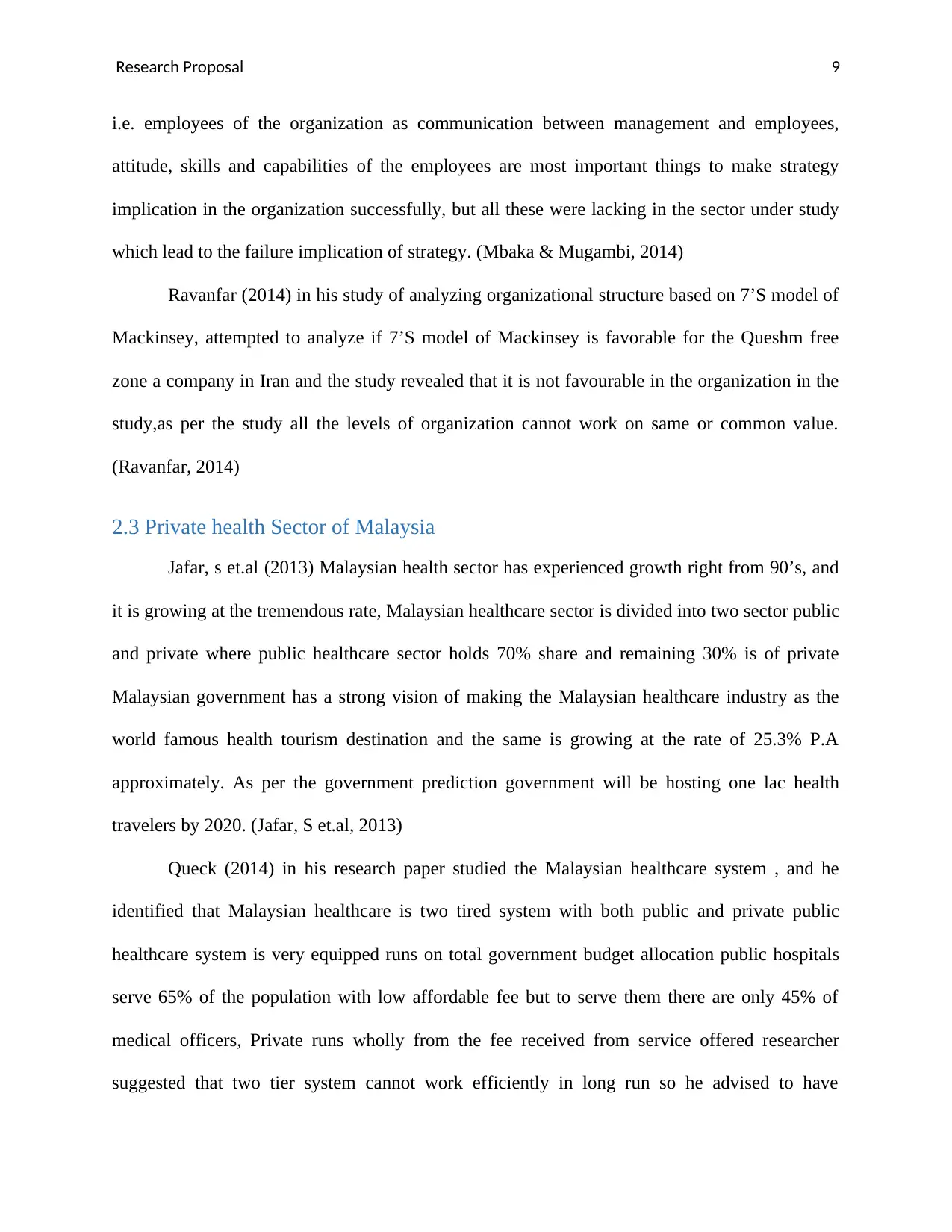
Research Proposal 9
i.e. employees of the organization as communication between management and employees,
attitude, skills and capabilities of the employees are most important things to make strategy
implication in the organization successfully, but all these were lacking in the sector under study
which lead to the failure implication of strategy. (Mbaka & Mugambi, 2014)
Ravanfar (2014) in his study of analyzing organizational structure based on 7’S model of
Mackinsey, attempted to analyze if 7’S model of Mackinsey is favorable for the Queshm free
zone a company in Iran and the study revealed that it is not favourable in the organization in the
study,as per the study all the levels of organization cannot work on same or common value.
(Ravanfar, 2014)
2.3 Private health Sector of Malaysia
Jafar, s et.al (2013) Malaysian health sector has experienced growth right from 90’s, and
it is growing at the tremendous rate, Malaysian healthcare sector is divided into two sector public
and private where public healthcare sector holds 70% share and remaining 30% is of private
Malaysian government has a strong vision of making the Malaysian healthcare industry as the
world famous health tourism destination and the same is growing at the rate of 25.3% P.A
approximately. As per the government prediction government will be hosting one lac health
travelers by 2020. (Jafar, S et.al, 2013)
Queck (2014) in his research paper studied the Malaysian healthcare system , and he
identified that Malaysian healthcare is two tired system with both public and private public
healthcare system is very equipped runs on total government budget allocation public hospitals
serve 65% of the population with low affordable fee but to serve them there are only 45% of
medical officers, Private runs wholly from the fee received from service offered researcher
suggested that two tier system cannot work efficiently in long run so he advised to have
i.e. employees of the organization as communication between management and employees,
attitude, skills and capabilities of the employees are most important things to make strategy
implication in the organization successfully, but all these were lacking in the sector under study
which lead to the failure implication of strategy. (Mbaka & Mugambi, 2014)
Ravanfar (2014) in his study of analyzing organizational structure based on 7’S model of
Mackinsey, attempted to analyze if 7’S model of Mackinsey is favorable for the Queshm free
zone a company in Iran and the study revealed that it is not favourable in the organization in the
study,as per the study all the levels of organization cannot work on same or common value.
(Ravanfar, 2014)
2.3 Private health Sector of Malaysia
Jafar, s et.al (2013) Malaysian health sector has experienced growth right from 90’s, and
it is growing at the tremendous rate, Malaysian healthcare sector is divided into two sector public
and private where public healthcare sector holds 70% share and remaining 30% is of private
Malaysian government has a strong vision of making the Malaysian healthcare industry as the
world famous health tourism destination and the same is growing at the rate of 25.3% P.A
approximately. As per the government prediction government will be hosting one lac health
travelers by 2020. (Jafar, S et.al, 2013)
Queck (2014) in his research paper studied the Malaysian healthcare system , and he
identified that Malaysian healthcare is two tired system with both public and private public
healthcare system is very equipped runs on total government budget allocation public hospitals
serve 65% of the population with low affordable fee but to serve them there are only 45% of
medical officers, Private runs wholly from the fee received from service offered researcher
suggested that two tier system cannot work efficiently in long run so he advised to have
Paraphrase This Document
Need a fresh take? Get an instant paraphrase of this document with our AI Paraphraser
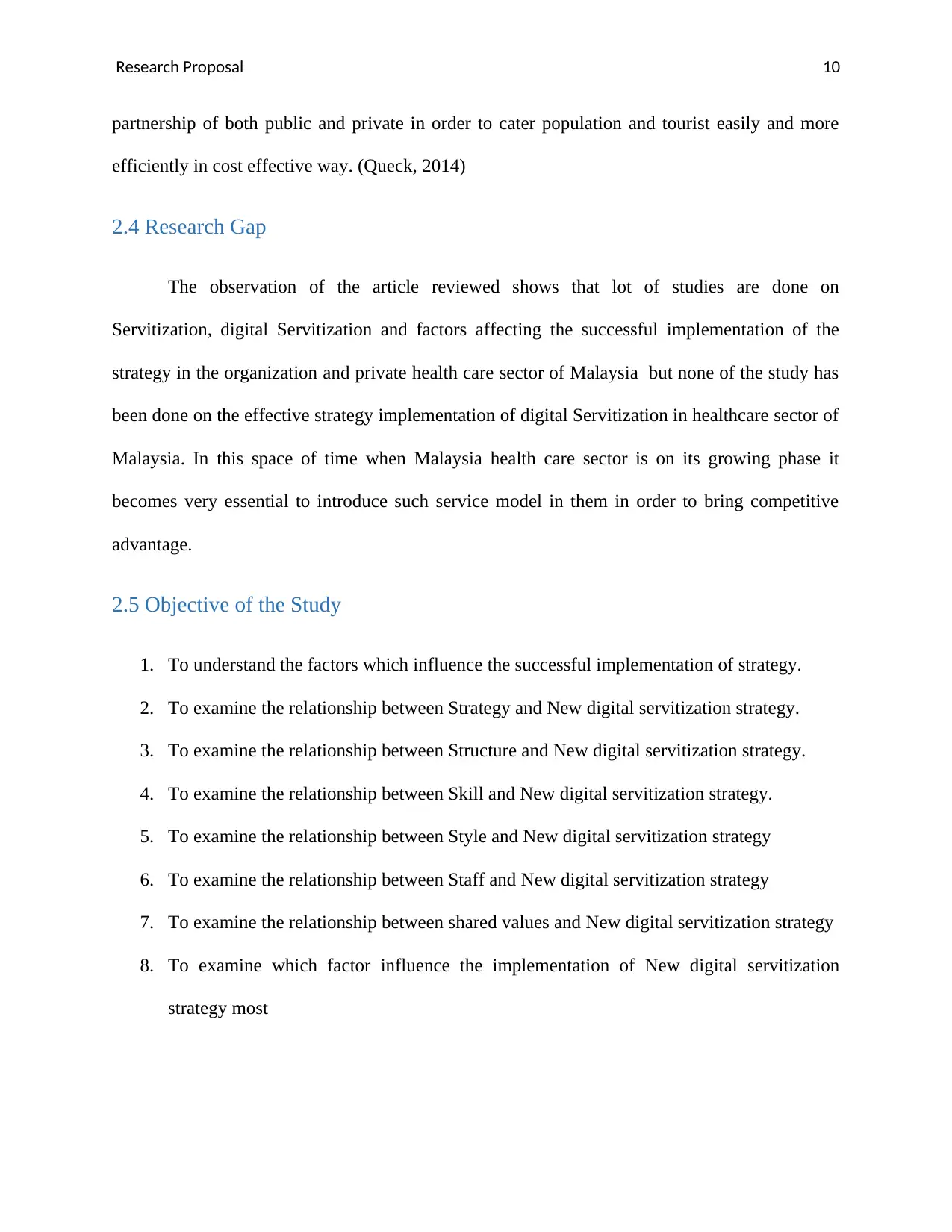
Research Proposal 10
partnership of both public and private in order to cater population and tourist easily and more
efficiently in cost effective way. (Queck, 2014)
2.4 Research Gap
The observation of the article reviewed shows that lot of studies are done on
Servitization, digital Servitization and factors affecting the successful implementation of the
strategy in the organization and private health care sector of Malaysia but none of the study has
been done on the effective strategy implementation of digital Servitization in healthcare sector of
Malaysia. In this space of time when Malaysia health care sector is on its growing phase it
becomes very essential to introduce such service model in them in order to bring competitive
advantage.
2.5 Objective of the Study
1. To understand the factors which influence the successful implementation of strategy.
2. To examine the relationship between Strategy and New digital servitization strategy.
3. To examine the relationship between Structure and New digital servitization strategy.
4. To examine the relationship between Skill and New digital servitization strategy.
5. To examine the relationship between Style and New digital servitization strategy
6. To examine the relationship between Staff and New digital servitization strategy
7. To examine the relationship between shared values and New digital servitization strategy
8. To examine which factor influence the implementation of New digital servitization
strategy most
partnership of both public and private in order to cater population and tourist easily and more
efficiently in cost effective way. (Queck, 2014)
2.4 Research Gap
The observation of the article reviewed shows that lot of studies are done on
Servitization, digital Servitization and factors affecting the successful implementation of the
strategy in the organization and private health care sector of Malaysia but none of the study has
been done on the effective strategy implementation of digital Servitization in healthcare sector of
Malaysia. In this space of time when Malaysia health care sector is on its growing phase it
becomes very essential to introduce such service model in them in order to bring competitive
advantage.
2.5 Objective of the Study
1. To understand the factors which influence the successful implementation of strategy.
2. To examine the relationship between Strategy and New digital servitization strategy.
3. To examine the relationship between Structure and New digital servitization strategy.
4. To examine the relationship between Skill and New digital servitization strategy.
5. To examine the relationship between Style and New digital servitization strategy
6. To examine the relationship between Staff and New digital servitization strategy
7. To examine the relationship between shared values and New digital servitization strategy
8. To examine which factor influence the implementation of New digital servitization
strategy most
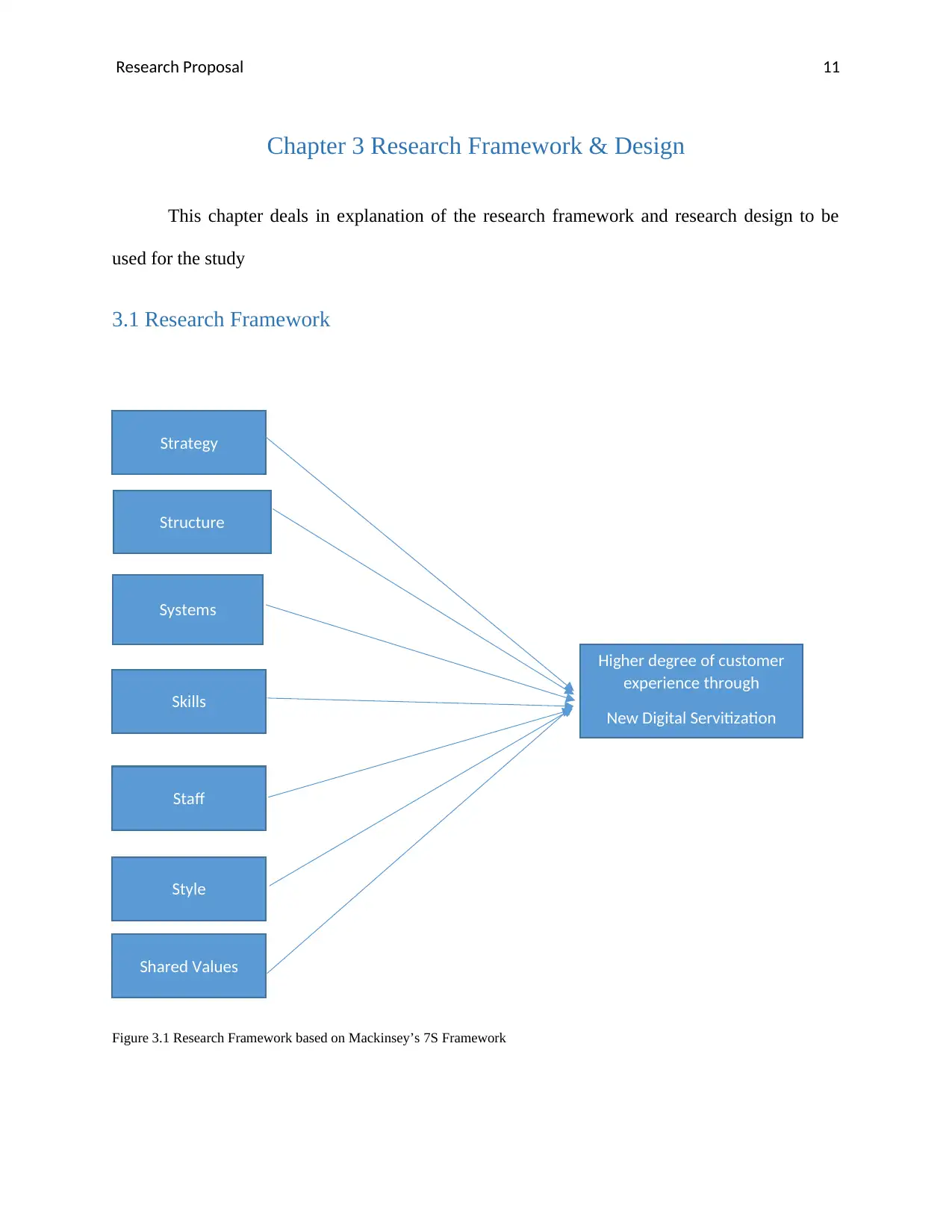
Research Proposal 11
Chapter 3 Research Framework & Design
This chapter deals in explanation of the research framework and research design to be
used for the study
3.1 Research Framework
Figure 3.1 Research Framework based on Mackinsey’s 7S Framework
Strategy
Structure
Systems
Higher degree of customer
experience through
New Digital Servitization
Strategy
Skills
Staff
Style
Shared Values
Chapter 3 Research Framework & Design
This chapter deals in explanation of the research framework and research design to be
used for the study
3.1 Research Framework
Figure 3.1 Research Framework based on Mackinsey’s 7S Framework
Strategy
Structure
Systems
Higher degree of customer
experience through
New Digital Servitization
Strategy
Skills
Staff
Style
Shared Values
⊘ This is a preview!⊘
Do you want full access?
Subscribe today to unlock all pages.

Trusted by 1+ million students worldwide
1 out of 21
Related Documents
Your All-in-One AI-Powered Toolkit for Academic Success.
+13062052269
info@desklib.com
Available 24*7 on WhatsApp / Email
![[object Object]](/_next/static/media/star-bottom.7253800d.svg)
Unlock your academic potential
Copyright © 2020–2025 A2Z Services. All Rights Reserved. Developed and managed by ZUCOL.





